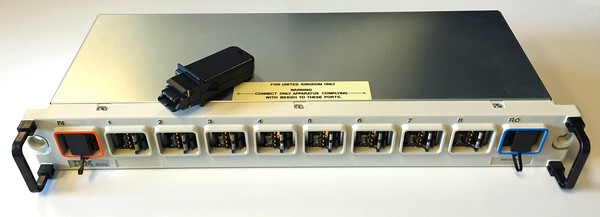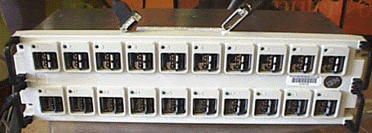|
8228 Overview (PDF, 2 pages)
8228 Sales Reference Sheet (PDF, 1 page)
8228 Official Web Page (archived)
MAU Inside (ccapitalia.net)
8228 Setup Aid
Overview
Oorts
MAU Intro
Oops! Pulling the plug...
Operational Sounds
8230 20-port LAM, not MAU
Overview (source)
The IBM 8228 Multistation Access Unit is a simple 8-lobe wiring concentrator
that can be installed in a rack in a wiring closet. Each 8228 allows up to
eight attaching devices to have access to a ring. The 8228 does not require
an external power source for operation.

The IBM 8228 Multistation Access Unit together with the original Setup Aid.
The IBM 8228 is an unintelligent, unpowered Token-Ring multistation access
unit. It can attach up to eight devices in a 4-Mbps or 16-Mbps TokenRing
network. Using IBM Cabling System ICS Connectors, cables from the
workstations or devices are simply plugged into the unit. The 8228 supports STP
cabling as well as UTP cabling when used with appropriate connectors or
filters.
8228s can be linked together to form rings that are larger than eight lobes
by attaching the RO receptacle of one 8228 to the RI receptacle of another
8228. The 8228 uses IBM type 1 or type 2 STP cabling and connectors.
Oorts
The advantage of the passive MAU is its simplicity. It contains a relay for
each workstation port, which is opened through a "phantom voltage" (DC-overlay
on the data-wires) and has two special ports "Ring In (RI)" and "Ring Out
(RO)", which are used to daisy-chain multiple MAU up to 240 user stations.
You don't need a "token server" for either IBM Token Ring or FDDI. Both of
them have protocols built into the network interface cards that start the token
and reconfigure the network when stations are added or removed.
Neither type goes down when a station is disconnected. The MAU closes the
circuit when it detects loss of connection, unless of course there's something
wrong with the MAU. When that happens the network cards reconfigure the ring in
a few milliseconds and you never notice that it was down briefly.
With IBM Token Ring, if the network is large enough to require two MAUs,
then if one of the connections from MAU to MAU is broken the MAUs can
reconfigure to run on the remaining cable (MAUs are always connected to each
other with two cables).
With FDDI, the ring can be configured as two rings with separate tokens, one
going around the ring in one direction and the other in the other. If there is
a break anywhere, the ring can reconfigure and keep running.
To connect Ethernet and Token Ring you need a router — the router
extracts data from Token Ring frames and reencapsulates it into Ethernet
frames. The type of network that can connect to Token Ring without a router is
100VG, which is designed for the purpose.
MAU Intro (from Peter)
The IBM passive MAU is the 8228 Model 001. It has 10 ports, 8 of them are
for user-stations, 1 is called Ring In, 1 is called Ring Out. These 2 are for
cascading multiple MAU up to 240 stations.
Front view of the IBM 8228 Multistation Access Unit (MAU):
+--------------------------------------------------------------------+
| H RI 1 2 3 4 5 6 7 8 RO H |
| H +---+ +---+ +---+ +---+ +---+ +---+ +---+ +---+ +---+ +---+ H |
| H | # | | # | | # | | # | | # | | # | | # | | # | | # | | # | H |
| H +---+ +---+ +---+ +---+ +---+ +---+ +---+ +---+ +---+ +---+ H |
| H H |
+--------------------------------------------------------------------+
| |__________________________________________| |
|
From To
another 8 connectors for stations another
8228 8228
(orange) (blue)
The original 8228 has connectors of IBM Cabling System (ICS) and use a very
unfamiliar plug, which is called 'Hermaphrodite Plug' and is plug and socket as
well. There are however compatible MAU available from i.e. AMP, which use RJ-45
connectors. The typical IBM Token-Ring cable has a 9 pin Sub-D plug on the
adapters end and an ICS plug on the MAU end. The cable can be extended very
easy using another cable with ICS-plugs on both ends. The maximum cable length
between MAU and station can be 300 feet at 4 MBit/s and 150 feet at 16
MBit/s.
One *can* create an own cable using shielded twisted pair cables like used
on telephone lines, if the length between adapter and MAU does not exceed 60
feet. (That's what I often did!) - the ICS plugs are available separately and
are very easy to install with only a larger plier to press in the self-cutting
cable connector. Takes about 2 minutes with some experience.
An IBM Token-Ring cabling consist out of 2 pairs of wires, which create a
system of 2 'rings' - one main data ring and an additional backup ring. The
topology is a star (the MAU in the center and the stations connecting with a
single cable to it), the logical architecture is of course a ring. Each station
inserts into this ring without disturbing data-traffic to the other stations
over the MAU. Token-Ring is -other than Ethernet- a collision-free transmission
and a failure in a single station or cable will not course larger segments to
crash.
There are 2 different TR-systems out: the 4 MBit/s and the 16 MBit/s
Token-Ring. If the cards have a round green decal at the rear bracket with 16/4
printed on it then these are the adapters which support both speeds. But you
will have to decide which speed you use - either 4 or 16. An adapter supporting
only 4 MBit/s or set to 4 MBit/s cannot work in a 16 MBit/s net and other way
round.
It is very easy to setup a small network under WfW 3.11, using the drivers
coming with WfW on the older standard MCA TR-adapters. You may have a dedicated
server but must not have one necessarily. If you share only resources like
disks or printers the Peer-To-Peer services will do. It will of course work
with Win95 as well, but I would not recommend Win95 for the old Mod. 70s. A
coexistence between WfW 3.11 and Win95 stations is possible. My personal
Token-Ring network in my home-office consists out of an IBM 8228, an 8595
Server running under Win95, 2 Win95 workstations (Compaq LTE-5380 and IBM
9556-0BA) and 2 WfW 3.11 workstations (PS/VP and Mod. 80-A31). Copying of data
among these machines works fine with no problems at 16 MBit/s.
Oops! Pulling the plug...
Hi Greg!
>Peter, if you have a smart MAU you are probably right but we have crashed a
lot of grocery stores by pulling the wrong plug using an 8228! I always told my
techs to never pull the PC end before they pulled the "IBM plug" and we stayed
out of trouble.
My home network bases on an 8228 and occasionally I ripped out the D-Sub
plug at the adapter card of a running machine. The station relay in the 8228
makes "clack" (closing - opposed to the "click" it switches on) - and nothing
else happened. I was just backing up another machine over the net to a tape on
a third active machine... the machine I disrupted from the net however spit
out a network error (logically). The rest of the net stayed stable.
You might come into troubled water if you only yank out the D-Sub
*partially* and the +5V phantom voltage is still present - which keeps the
station relay up... in this case the transmitter / receiver lines might be
interrupted and the Token gets lost... and if this machine accidentally was
your "active token monitor" (the first station that sets the initial Token) it
might cause the other stations going into idle (that "tick - tick - tick" under
DOS-LAN) or cause a beakoning condition while other active ring monitors try to
substitute the lost Token. This happens occasionally in my network when I pull
the PCMCIA TR-card from my Laptop in an absent-minded state before powering the
machine down :-)
Operational Sounds
The 8228 is silent as a grave usually. No PSU, no fan, no harddisk, no
speaker. It "Clicks" once a station inserts in the ring at power up and
starting the adapter. It "Clacks" once a station adapter is shut down. It
click-clack-click-clack-clicks" when Auto-speed adapters try figuring out
what's the ring speed and -finally- enter the ring. It "click-clacks" multiple
if a station tries entering the ring at fixed set a false speed, which could
cause more "clacks" when the other station adapters are shut due to a
"beaconing condition" on the ring (token got lost / adapter shut down and try
to re-insert) which then may cause some speaker noise ("BIPP!") on the
workstation(s) under DOS LAN Manager to notify the user / admin of that
beaconing condition.
However, all these noises are of a pretty low level but still easily audible
when you are sitting close to the unit. With other equipment running in the
background, you will have trouble hearing the clicks and clacks.
8230 20-port LAM, not MAU

Image from Symmetry
Computers.
Part Number: 53F5501. Has 20 Token Ring ports. Also has 9-pin and 25-pin
ports in back of unit.
Peter fires back:
This isn't a MAU, it's a LAM - Lobe Access Module and 1/4th of a
8230 MAU installation. You need the 8230 base (controller) unit to use the
LAMs. The LAMs come either in 20 x ICS or 20 x RJ-45. They can be used in mixed
configurations.
|